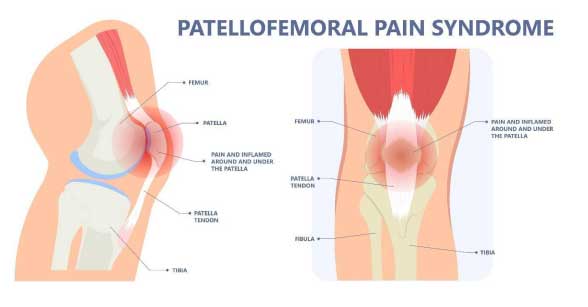Patellofemoral Pain Syndrome (Runner’s Knee): Causes, Signs and Symptoms, Diagnosis. Are you a female athlete or a weekend warrior? Now that you’re older (late 20s, 30s, 40s, or 50s), do your knees crack or pop when you stand from sitting after lengthy periods of time? Did you once enjoy the window seat on an airplane but now request a seat near the aisle? Have you stopped wearing high-heeled shoes because the angle from the height of the heel now puts pressure on your knees causing unbearable discomfort when you stand or walk? If you answered yes to these questions, then you may have Patellofemoral Pain Syndrome, also known as Runner’s Knee. Read the information below for more details.
What is Patellofemoral Pain Syndrome (Runner’s Knee)?
● Patellofemoral Pain Syndrome (Runner’s Knee) is pain located in the front of the knee and
around the patella (kneecap).
● This type of pain is common in mostly females (though it can occur in males) and young adults,
who are athletic or non-athletic.
Causes
● Malalignment of the kneecap
● Overuse from intense exercise or training
● Improper training techniques
● A change in footwear or playing surface
Signs and Symptoms
● Pain caused by exercise and activity that repeatedly bends the knee, walking upstairs, running, jumping, or squatting
● Pain at the front of the knee after sitting for prolonged periods of time with the knee bent
● Popping or crackling sounds in the knee when standing after prolonged sitting or walking up stairs
Diagnosis
● Follow-up with your primary care physician or general practitioner for an assessment
● X-rays of the affected knee(s)
● Magnetic Resonance Imaging (MRI) of the affected knee(s)
Treatment
● NSAIDs (Ibuprofen or Naproxen) can be taken for pain relief.
● Physical therapy is important to provide relief, adjust daily activity level, to help strengthen and stretch the muscles (quadriceps, hamstrings, abdominal core, lower back, and calves), and improve range of motion and endurance.
● Orthotics (shoe inserts) can help realign the foot and ankle.
● Surgical treatment is rarely needed.

References
Gaitonde, D., Ericksen, A., & Robbins, R. (2019). Patellofemoral Pain Syndrome. https://www.aafp.org/afp/2019/0115/p88.html
OrthoInfo. (2022). Patellofemoral Pain Syndrome. https://orthoinfo.aaos.org/en/diseases–conditions/patellofemoral-pain-syndrome/
RumRuay. (2022). [Illustration]. patella pain cap knee tear Torn injury Swelling bone leg exercise muscle jumper’s runner’s bursitis tendon tibia Anterior Cruciate Ligament ACL sport femur painful it band rupture Trauma joint cyst. https://www.shutterstock.com/image-vector/patella-pain-cap-knee-tear-torn-1997940665
So, N. (2020). Patellofemoral Syndrome Clinical Presentation. https://emedicine.medscape.com/article/308471-clinical
